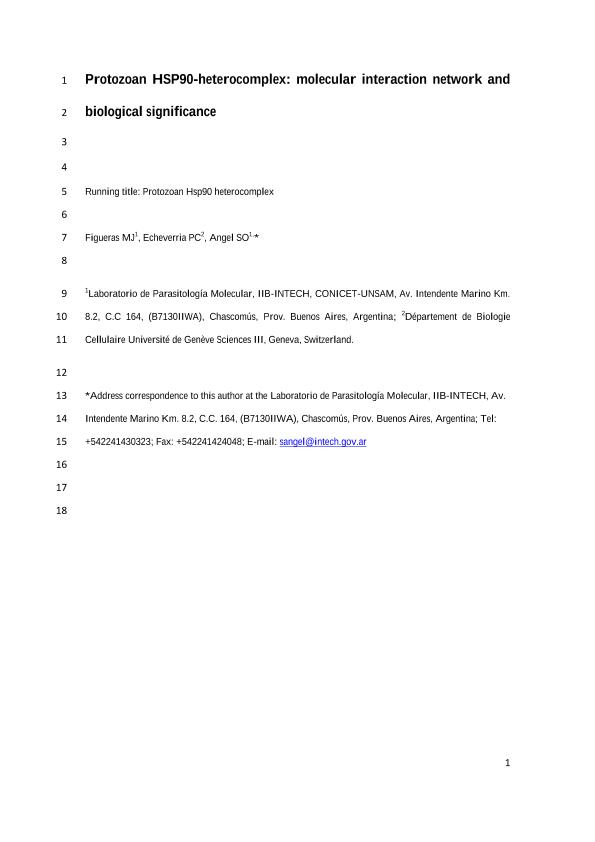Mostrar el registro sencillo del ítem
dc.contributor.author
Figueras López, María Julia

dc.contributor.author
Echeverria, Pablo Christian

dc.contributor.author
Angel, Sergio Oscar

dc.date.available
2016-12-02T21:09:16Z
dc.date.issued
2014-05
dc.identifier.citation
Figueras López, María Julia; Echeverria, Pablo Christian; Angel, Sergio Oscar; Protozoan HSP90-heterocomplex: molecular interaction network and biological significance; Bentham Science Publishers; Current Protein And Peptide Science; 15; 3; 5-2014; 245-255
dc.identifier.issn
1389-2037
dc.identifier.uri
http://hdl.handle.net/11336/8738
dc.description.abstract
The HSP90 chaperone is a highly conserved protein from bacteria to higher eukaryotes. In eukaryotes, this chaperone participates in different large complexes, such as the HSP90 heterocomplex, which has important biological roles in cell homeostasis and differentiation. The HSP90-heterocomplex is also named the HSP90/HSP70 cycle because different co-chaperones (HIP, HSP40, HOP, p23, AHA1, immunophilins, PP5) participate in this complex by assembling sequentially, from the early to the mature complex. In this review, we analyze the conservation and relevance of HSP90 and the HSP90-heterocomplex in several protozoan parasites, with emphasis in Plasmodium spp., Toxoplasma spp., Leishmania spp. and Trypanosoma spp. In the last years, there has been an outburst of studies based on yeast two-hybrid methodology, co-immunoprecipitation-mass spectrometry and bioinformatics, which have generated a most comprehensive protein-protein interaction (PPI) network of HSP90 and its co-chaperones. This review analyzes the existing PPI networks of HSP90 and its co-chaperones of some protozoan parasites and discusses the usefulness of these powerful tools to analyze the biological role of the HSP90-heterocomplex in these parasites. The generation of a T. gondii HSP90 heterocomplex PPI network based on experimental data and a recent Plasmodium HSP90 heterocomplex PPI network are also included and discussed. As an example, the putative implication of nuclear transport and chromatin (histones and Sir2) as HSP90-heterocomplex interactors is here discussed.
dc.format
application/pdf
dc.language.iso
eng
dc.publisher
Bentham Science Publishers

dc.rights
info:eu-repo/semantics/openAccess
dc.rights.uri
https://creativecommons.org/licenses/by-nc-sa/2.5/ar/
dc.subject
Toxoplasma Gondii
dc.subject
Hsp90-Heterocomplex
dc.subject
Protozoan
dc.subject
Molecular Interactions
dc.subject.classification
Biología Celular, Microbiología

dc.subject.classification
Ciencias Biológicas

dc.subject.classification
CIENCIAS NATURALES Y EXACTAS

dc.title
Protozoan HSP90-heterocomplex: molecular interaction network and biological significance
dc.type
info:eu-repo/semantics/article
dc.type
info:ar-repo/semantics/artículo
dc.type
info:eu-repo/semantics/publishedVersion
dc.date.updated
2016-11-25T16:35:20Z
dc.journal.volume
15
dc.journal.number
3
dc.journal.pagination
245-255
dc.journal.pais
Estados Unidos

dc.journal.ciudad
Boca Raton
dc.description.fil
Fil: Figueras López, María Julia. Consejo Nacional de Investigaciones Científicas y Técnicas. Centro Científico Tecnológico la Plata. Instituto de Investigaciones Biotecnológicas - Instituto Tecnológico Chascomús. Instituto de Investigaciones Biotecnológicas (sede Chascomús); Argentina
dc.description.fil
Fil: Echeverria, Pablo Christian. Consejo Nacional de Investigaciones Científicas y Técnicas. Centro Científico Tecnológico La Plata. Instituto de Investigaciones Biotecnológicas - Instituto Tecnológico Chascomús. Instituto de Investigaciones Biotecnológicas (sede Chascomús); Argentina. Universidad de Ginebra; Suiza
dc.description.fil
Fil: Angel, Sergio Oscar. Consejo Nacional de Investigaciones Científicas y Técnicas. Centro Científico Tecnológico la Plata. Instituto de Investigaciones Biotecnológicas - Instituto Tecnológico Chascomús. Instituto de Investigaciones Biotecnológicas (sede Chascomús); Argentina
dc.journal.title
Current Protein And Peptide Science

dc.relation.alternativeid
info:eu-repo/semantics/altIdentifier/url/http://www.eurekaselect.com/121280/article
dc.relation.alternativeid
info:eu-repo/semantics/altIdentifier/doi/http://dx.doi.org/10.2174/1389203715666140331114233
Archivos asociados
